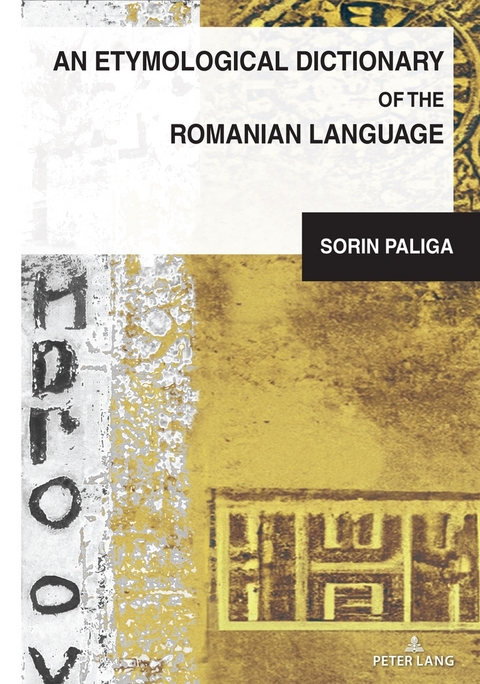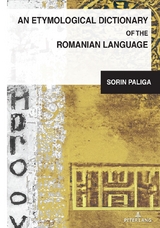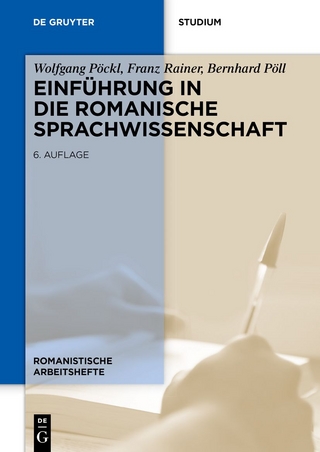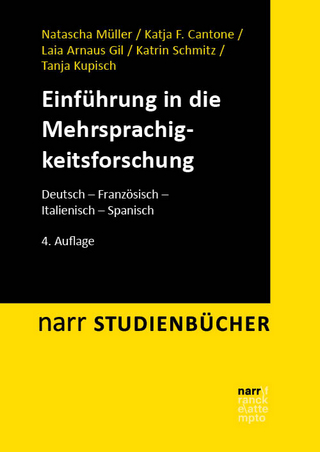An Etymological Dictionary of the Romanian Language
Peter Lang Publishing Inc (Verlag)
978-1-63667-141-3 (ISBN)
The book is a first attempt to analyze the complex problems of Romanian etymology in English. Romanian is a Romance language, but it also inherits an old Pre-Romance layer represented by both Indo-European and Pre-Indo-European elements such as Greek and Albanian. The book is divided into three parts. Part 1 is an extensive introduction which summarises the archaeological, historical, and linguistic problems of southeast Europe, with a focus on Romanian and its neighboring languages (the Slavic languages and Hungarian). It reviews various hypotheses regarding the region’s prehistoric cultures and how they developed across millennia; it continues with the Thracian cultural groups, which represent the substratum of Romanian, and how these groups underwent a long and complex process of Romanization; and finally, it analyzes the migration period and the new cultural groups that emerged during this long period.
Part 2, the dictionary, includes more than 5,000 entries reflecting the representative vocabulary, but also rare and dialectal words, and words referring to flora and fauna. It covers the old Latin heritage, the substratum heritage, and Slavic, Hungarian and Ottoman influences, as well as some relevant neo-Romance elements ("the New Romanization of Romanian", a mainly nineteenth-century process.). Part 3 includes a glossary, as well as lists of the relevant prehistoric roots quoted in the dictionary.
Sorin Paliga graduated from the University of Bucharest in 1980. He studied Czech and English, also Slovene, Polish, and Portuguese. His main interests were primarily focused on Central European cultures and languages (mainly Czech, Slovak, and Slovene), but also on southeast Europe and its fascinating evolution from the Neolithic Revolution (8th millennium BCE) until now. His doctoral thesis analyzed the Romance and Pre-Romance (Thracian and Illyrian) influences in South Slavic (1998). Many of the published works cover linguistic and historical problems of Southeast and Central Europe, and are available on academia.edu and researchgate.net. He has translated books from Czech, English, and French. The Czech Ministry of Foreign Affairs awarded him the special prize for his activity in promoting Czech culture abroad in 2009.
Tabula Gratulatoria xv
Abbreviations, Etymological Dictionaries and References xvi
a. Abbreviations...............................................................................................................................xvi
b. Etymological and Bilingual Dictionaries with Etymological Relevance.........................................xxi
c. General References (Studies, Books)...........................................................................................xxiv
d. Author’s Studies and Books......................................................................................................xxxiii
Chapter I. General Considerations 1
A New Etymological Dictionary of Romanian. Why?.............................................................................6
Histories of the Romanian Language....................................................................................................12
A Historical View of the ‘Romanian Etymological Problem’.................................................................14
Thracians, Romanians, Albanians, Slavs: Ethnicity in Central and Southeast Europe............................17
General Problems..........................................................................................................................17
The Languages Spoken in the Antiquity........................................................................................19
The Slavic Homeland....................................................................................................................22
The Structure of the Slavic Vocabulary..........................................................................................29
Albanian and Albanians................................................................................................................31
‘The Homeland of the Romanians’................................................................................................36
The Vlachs (Vlakhs). Are They ‘A Kind of Romanians’ or ‘Genuine Romanians’?.................................38
Back to Linguistics...............................................................................................................................41
The ‘Balkan Linguistic Union’ (Balkansprachbund).......................................................................47
Romanian, Its Origins and Its Neighbors......................................................................................49
The Structure of the Romanian Vocabulary...................................................................................55
Chapter II. The Strata of the Romanian Vocabulary 59
The Romanian Language: Its Stratification and the Statistical Data......................................................60
The Latin Heritage...............................................................................................................................61
The Substratum Heritage......................................................................................................................62
Words Shared with Albanian of Non- Latin Origin...............................................................................62
The Slavic Influence.............................................................................................................................63
Statistical Data...................................................................................................................................63
1.a. The Old Latin Heritage..........................................................................................................63
1.b. The New Modern Borrowings of Latin Origin.......................................................................64
2. The Chaotic Group Labeled ‘Unknown Etymology’ (‘et. nec.’) in DEX.................................65
3. The Romanian- Albanian Common Heritage..........................................................................65
4. Re- organizing the ‘et. nec.’ Data as Substratum Elements......................................................66
5. The Slavic Influence from the Statistical Perspective...............................................................66
6. The Hungarian (Magyar) Influence........................................................................................67
7. The Turkish Influence............................................................................................................67
The Swadesh List for Romanian...........................................................................................................67
An Alternative List of 100 Roots...................................................................................................75
Analysis of the Two Lists...............................................................................................................85
Analysis of the Three Scenarios......................................................................................................87
Chapter III. Place- Names and Personal Names 89
Place Names.......................................................................................................................................89
Personal Names..................................................................................................................................94
Chapter IV. The Romanian Language: Structure, Heritage, Etymological Problems 97
A Brief Synthesis.................................................................................................................................97
The Nominal Sphere............................................................................................................................97
Noun.................................................................................................................................................97
Adjective and Adverb.........................................................................................................................100
Pronoun...........................................................................................................................................101
Article..............................................................................................................................................103
The Definite Article of Nouns and Adjectives......................................................................104
The Definite Article in Albanian v. Romanian.....................................................................105
The Definite Article of Demonstratives and Adverbs...........................................................107
Two Exceptional Forms: tată/ tata ‘father’ and popă/ popa ‘a priest’......................................108
The Definite Article of Personal Names...............................................................................109
Summing Up......................................................................................................................110
Verb.................................................................................................................................................110
The Verbs a fi ‘to be’, a aveá ‘to have’ and the Suppletive Forms a vrea, a voi ‘to wish, will’..........112
Conclusions................................................................................................................................115
Numeral...........................................................................................................................................116
Non- Inflected Forms..........................................................................................................................116
Derivational Means............................................................................................................................117
Reduplication...................................................................................................................................117
Affixes: Prefixes and Suffixes...............................................................................................................118
Conclusions.....................................................................................................................................120
Chapter V. Romanian Phonetics and Phonology 121
The Specific Vowels of Romanian.......................................................................................................122
The Consonantal System of Romanian...............................................................................................126
Diphthongs and Triphthongs.............................................................................................................127
The Phonemes [oe] and [oe̯]................................................................................................................127
Letter i.............................................................................................................................................128
Historical Phonetics...........................................................................................................................128
Some Basic Problems of Phonetic Evolution...............................................................................129
Colloquial Latin..........................................................................................................................130
Tentative Phonetic Reconstructions for Thracian................................................................................133
Vocalism...................................................................................................................................133
Consonantism.............................................................................................................................134
The Indo- European Sonants ḷ ṛ ṃ ṇ............................................................................................136
A General Tableau.......................................................................................................................136
The Slavic Phonetic Inventory............................................................................................................137
Vocalism...................................................................................................................................137
Consonantism.............................................................................................................................137
Interferences Between Proto- Romanian, Thracian and Slavic..............................................................138
Treatment of Proto- Romanian Vowels................................................................................................138
Treatment of Proto- Romanian Consonants........................................................................................139
Addenda 143
I. A Note on Romanian Spelling.....................................................................................................143
II. A Comparative Analysis of the Transcriptions Used for the Romanian Dialects...........................145
PART II
The Etymological Dictionary in alphabetical order 153
PART III
Addenda 529
Glossary...........................................................................................................................................529
– Prehistoric Roots.............................................................................................................................536
– Pre- Indo- European Roots................................................................................................................539
– Proto- Boreal (‘Nostratic’) Roots......................................................................................................554
– Indo- European Roots......................................................................................................................575
This etymological dictionary constitutes a novel and provoking contribution to the field, and is likely to prove useful for those of those unfamiliar with specific problems posed by Eastern Romance linguistics. The inclusion of introductory chapters devoted to history, phonetics and morphology, and statistical charts, will be welcomed by non-expert readers.
Sorin Paliga’s Etymological Dictionary of Romanian seeks to fill a gap in contemporary lexicography in so far as it approaches the very complex case of Romanian considering all perspectives and applying the techniques of contemporary historical and comparative linguistics. It takes account of the difficulties inherent in the special position of Romanian as a Romance language situated in a Sprachbund comprising languages both related and unrelated to Indo-European, and specifically surrounded by South-Slavic languages and Hungarian.
As everybody knows, the question of the identification of Romanian with the Romance dialect of the Pannonian Plain, which infiltrated into Transilvania after the decline of the Roman Empire, or, alternatively, with the Latin dialect spoken in Dacia and more southern regions after the comparatively late Roman conquest, is subject to intense debate, and this makes the description of the history of the language and the study of its connections more difficult than that of other Romance languages.
The most daring part of this kind of work is, of course, the assumed existence of a substrate language or group of languages that we know very little about, as well as the uncertainties about its initial locus and spread in the so-called “dark ages”. As is well known, several attempts to identify this substrate have been made: Hans Krahe’s Alteuropäisch covered the best part of Europe, and, in spite of the meagre or nonexistent written evidence for these dialects, Dacian, Illyrian and Pannonian (a label accepted by some scholars but without direct testimonies) are conceivable candidates.
In sum, this etymological dictionary constitutes a novel and provoking contribution to the field, and is likely to prove useful for those of the author’s colleagues unfamiliar with specific problems posed by Eastern Romance linguistics. The inclusion of introductory chapters devoted to history, phonetics and morphology, and statistical charts, will be welcomed by non-expert readers.
Blanca María Prósper
University of Salamanca
Departamento de Filología Clásica e Indoeuropeo
| Erscheinungsdatum | 13.10.2023 |
|---|---|
| Reihe/Serie | South-East European History ; 4 |
| Mitarbeit |
Herausgeber (Serie): Mihai Dragnea |
| Verlagsort | New York |
| Sprache | englisch |
| Maße | 1778 x 254 mm |
| Gewicht | 1239 g |
| Themenwelt | Literatur ► Romane / Erzählungen |
| Kunst / Musik / Theater ► Kunstgeschichte / Kunststile | |
| Schulbuch / Wörterbuch ► Wörterbuch / Fremdsprachen | |
| Geisteswissenschaften ► Sprach- / Literaturwissenschaft ► Romanistik | |
| Geisteswissenschaften ► Sprach- / Literaturwissenschaft ► Sprachwissenschaft | |
| ISBN-10 | 1-63667-141-1 / 1636671411 |
| ISBN-13 | 978-1-63667-141-3 / 9781636671413 |
| Zustand | Neuware |
| Haben Sie eine Frage zum Produkt? |
aus dem Bereich




